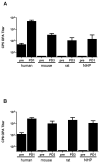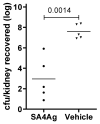Performance of a Four-Antigen Staphylococcus aureus Vaccine in Preclinical Models of Invasive S. aureus Disease
- PMID: 33467609
- PMCID: PMC7830931
- DOI: 10.3390/microorganisms9010177
Performance of a Four-Antigen Staphylococcus aureus Vaccine in Preclinical Models of Invasive S. aureus Disease
Abstract
A Staphylococcus aureus four-antigen vaccine (SA4Ag) was designed for the prevention of invasive disease in surgical patients. The vaccine is composed of capsular polysaccharide type 5 and type 8 CRM197 conjugates, a clumping factor A mutant (Y338A-ClfA) and manganese transporter subunit C (MntC). S. aureus pathogenicity is characterized by an ability to rapidly adapt to the host environment during infection, which can progress from a local infection to sepsis and invasion of distant organs. To test the protective capacity of the SA4Ag vaccine against progressive disease stages of an invasive S. aureus infection, a deep tissue infection mouse model, a bacteremia mouse model, a pyelonephritis model, and a rat model of infectious endocarditis were utilized. SA4Ag vaccination significantly reduced the bacterial burden in deep tissue infection, in bacteremia, and in the pyelonephritis model. Complete prevention of infection was demonstrated in a clinically relevant endocarditis model. Unfortunately, these positive preclinical findings with SA4Ag did not prove the clinical utility of SA4Ag in the prevention of surgery-associated invasive S. aureus infection.
Keywords: ClfA; MntC; SA4Ag vaccine; Staphylococcus aureus; animal models; conjugated polysaccharide; invasive disease; protection; sepsis; surgery-associated infection.
Conflict of interest statement
I.L.S., Y.T., A.I., P.A.L., K.U.J. and A.S.A. are employees of Pfizer Inc. and may hold stock or stock options. P.L. was an employee of Pfizer at the time the work was done.
Figures



Similar articles
-
SA4Ag, a 4-antigen Staphylococcus aureus vaccine, rapidly induces high levels of bacteria-killing antibodies.Vaccine. 2017 Feb 22;35(8):1132-1139. doi: 10.1016/j.vaccine.2017.01.024. Epub 2017 Jan 28. Vaccine. 2017. PMID: 28143674 Clinical Trial.
-
Safety, tolerability, and immunogenicity of a novel 4-antigen Staphylococcus aureus vaccine (SA4Ag) in healthy Japanese adults.Hum Vaccin Immunother. 2018;14(11):2682-2691. doi: 10.1080/21645515.2018.1496764. Epub 2018 Aug 17. Hum Vaccin Immunother. 2018. PMID: 30084709 Free PMC article.
-
Safety, tolerability, and immunogenicity of a single dose 4-antigen or 3-antigen Staphylococcus aureus vaccine in healthy older adults: Results of a randomised trial.Vaccine. 2017 Jan 5;35(2):385-394. doi: 10.1016/j.vaccine.2016.11.032. Epub 2016 Nov 17. Vaccine. 2017. PMID: 27866765 Clinical Trial.
-
The development of a staphylococcus aureus four antigen vaccine for use prior to elective orthopedic surgery.Hum Vaccin Immunother. 2019;15(2):358-370. doi: 10.1080/21645515.2018.1523093. Epub 2018 Sep 27. Hum Vaccin Immunother. 2019. PMID: 30215582 Free PMC article. Review.
-
Covering all the Bases: Preclinical Development of an Effective Staphylococcus aureus Vaccine.Front Immunol. 2014 Mar 24;5:109. doi: 10.3389/fimmu.2014.00109. eCollection 2014. Front Immunol. 2014. PMID: 24715889 Free PMC article. Review.
Cited by
-
Efficacy of a 4-Antigen Staphylococcus aureus Vaccine in Spinal Surgery: The STaphylococcus aureus suRgical Inpatient Vaccine Efficacy (STRIVE) Randomized Clinical Trial.Clin Infect Dis. 2023 Jul 26;77(2):312-320. doi: 10.1093/cid/ciad218. Clin Infect Dis. 2023. PMID: 37125490 Free PMC article. Clinical Trial.
-
Bacterial Lipoprotein Posttranslational Modifications. New Insights and Opportunities for Antibiotic and Vaccine Development.Front Microbiol. 2021 Dec 7;12:788445. doi: 10.3389/fmicb.2021.788445. eCollection 2021. Front Microbiol. 2021. PMID: 34950121 Free PMC article. Review.
-
The Candidate Antigens to Achieving an Effective Vaccine against Staphylococcus aureus.Vaccines (Basel). 2022 Jan 27;10(2):199. doi: 10.3390/vaccines10020199. Vaccines (Basel). 2022. PMID: 35214658 Free PMC article. Review.
-
Vaccination With Detoxified Leukocidin AB Reduces Bacterial Load in a Staphylococcus aureus Minipig Deep Surgical Wound Infection Model.J Infect Dis. 2022 Apr 19;225(8):1460-1470. doi: 10.1093/infdis/jiab219. J Infect Dis. 2022. PMID: 33895843 Free PMC article.
-
Exploring the role of bacterial virulence factors and host elements in septic arthritis: insights from animal models for innovative therapies.Front Microbiol. 2024 Feb 12;15:1356982. doi: 10.3389/fmicb.2024.1356982. eCollection 2024. Front Microbiol. 2024. PMID: 38410388 Free PMC article. Review.
References
-
- Noskin G.A., Rubin R.J., Schentag J.J., Kluytmans J., Hedblom E.C., Jacobson C., Smulders M., Gemmen E., Bharmal M. National trends in Staphylococcus aureus infection rates: Impact on economic burden and mortality over a 6-year period (1998–2003) Clin. Infect. Dis. 2007;45:1132–1140. doi: 10.1086/522186. - DOI - PubMed
LinkOut - more resources
Full Text Sources
Other Literature Sources

